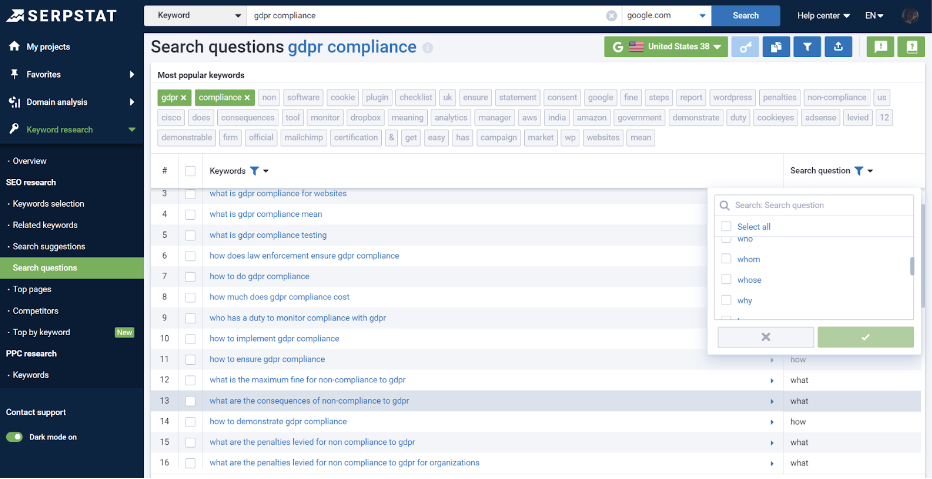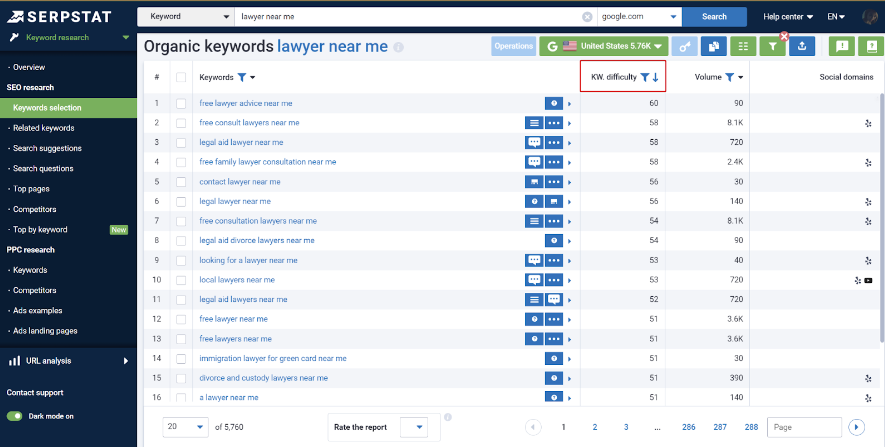Start Exploring Keyword Ideas
Use Serpstat to find the best keywords for your website
Keyword Difficulty: What Is It and Why It Matters?


Nowadays, getting on the first page of SERP for any keyword is difficult. Gone are the days when it was enough to put a main keyword at the beginning of the text in your post, and you got the top 1 position. To overtake existing sites, there are several SEO metrics, such as search volume, cost per click, keyword difficulty (KD), etc., that must be considered before choosing a keyword.
The Keyword SEO difficulty will allow you to estimate the effort required to succeed. Also, this metric will help you decide which page of the site should be targeted for each group of keywords.
Our honorable experts from Twitter Chat will share their experience in using keywords and different metrics to measure them:


Join #serpstat_chat to discuss practical SEO, trends, and updates with SEO experts.
We conduct them every Thursday at 2 pm ET | 11 am PT on our Twitter channel by hashtag #serpstat_chat.
What Is Keyword Difficulty?
Before delving into how to check keyword difficulty, let's clarify this term. Keyword difficulty is one of the most important SEO metrics, which shows how difficult it is for a keyword to get the top positions on search engine results pages. People new to SEO may confuse the KD metric with the keyword competition metric in Google Keyword Planner. Keyword competition refers only to paid search results, and keyword difficulty score refers to organic search results.
The higher the SEO KD index for any keyword is, the higher the competition and the less chance of ranking for that keyword. The lower the KD index for any keyword, the lower the competition and the higher the probability that it will outperform existing sites for the same keyword. Therefore, choosing keywords with a low keyword difficulty index is always recommended for beginners.
“Going by the concept of “competition,” competition has two main dimensions: quantity and quality. Some terms have lots of “competition” (pages that are relevant), but much of it may be weak – due to the term not being the primary target.”
So, are easier keywords easier to rank for?
“By easier, we mean less competitive keywords. If you write enough about a topic and sprinkle the easier keywords (1-2% of the total post), you should be able to rank in a shorter time. It also depends if other websites are doing the same in your niche.”
Why Is Keyword Difficulty Important?
Proper keyword research means understanding its potential revenue, its competitiveness, and even what content you need to create to be able to rank for it. In a nutshell: proper keyword research can be the difference between an incredibly successful SEO campaign that makes your business tons of money and a complete waste of time and money. If you set up your keyword research correctly, scaling your current SEO measures and driving your growth will be relatively easy.
“Many resources advise targeting one main keyword and two to three variations of that keyword. Each keyword will lose power if you target more than one on a page.”
Let’s learn some critical, meaningful factors in the keyword difficulty analysis.
- Search intent is one of the most critical factors determining the KD score. It is simply related to the purpose behind the request that any user is looking for.
- Domain authority. It is practically impossible to overtake more authoritative sites. It implies high difficulty if Google SERPs only show high-authority websites on the first page.
- Backlinks are considered the basis of off-page SEO and play a vital role in getting ahead of already-ranked sites. If you see that currently ranked websites have backlinks from high-authority sites, this indirectly indicates high difficulty for keywords.
- Content quality is another aspect that has the most significant importance when calculating the keyword competition score. This can be analyzed by studying the content of sites on the first page of Google for the keyword you want to rank for.
“Use Google to do a search and scroll to the bottom to see the questions asked. Those are keywords you can research and use to reach that audience. You can also use Google Trends for research. Along with fab SEO tools like Serpstat.”

“Use Serpstat keyword planner and spend some time looking at the data it shows you to determine a trend of searches to target.”
Your primary research must be comprehensive because it will be the basis of your SEO strategy. At this initial research stage, your goal is to collect as many relevant keywords as possible that could reach your audience.
“Find as many keywords as your topic deserves. If it’s a very niche topic, “Should you include a thank you page in your sitemap,” then it’s a small set of keywords. If it’s larger “All about Sitemaps,” then you’re much higher in #.”
Unlock the full potential of your SEO strategy with professional keyword research!
Sign up for a free trial of Serpstat today and experience the power of advanced keyword analysis tools. Take advantage to boost your search engine rankings and drive more organic traffic to your website.
Try Serpstat now!How to Measure Keyword Difficulty?
What is good keyword ranking difficulty? There is no specific value that can be considered a good KD. The difficulty of a keyword is measured on a scale from 0 to 100, and the lower the indicator, the easier it is to rank by the word.
There are two common ways to calculate keyword difficulty score:
- By analyzing backlinks of top domains
Within the first method, KD is the average value of the number of backlinks every domain in the top 10 has.
- By analyzing backlinks of top URLs
This method lies in calculating the number of backlinks every page in the top 10 has, where KD is an average value. Sure, backlinks are the crucial ranking factor for measuring keyword difficulty, but not only one. That's why this method cannot be considered a perfect one.
“Meta tags are a huge ranking signal to search engines about what keywords you are trying to target. Without them, robots and people without sight could not properly use your website.”
“I also use the classic method to find easy keywords and sites which I can replicate to rank easily. ”
Serpstat KD considers the type of keyword – whether commercial or not. We use particular coefficients to calculate the "commerciality" of the request. Serpstat's algorithm is based on a formula of three indicators:
- number of backlinks;
- URL complexity;
- "commercial/noncommercial" types of requests.
Serpstat calculates the backlinks toward the top 10 pages and determines the average keyword difficulty. To enhance the precision of the results, the algorithm also examines various other factors, including the quantity of unique referring domains, the presence of a keyword in the title of the domain and URL, and the main pages appearing in search engine results pages.
How to Use Keyword Difficulty in an SEO Strategy?
By monitoring the Keyword Difficulty index from a KD analysis in SEO tools, you gain valuable insights into the best-performing keywords and phrases to help you rank higher in search results. This analysis allows you to identify a range of achievable keywords in your niche and optimize your efforts, maximizing the chances of ranking success, even if your website is relatively new. By focusing on high-performing, “hot” keywords, you can efficiently allocate your time and resources to yield the best results.
“While there is no specific guideline on the number of keywords to include, most experts recommend using one keyword per 100 words of text.”
Here is how to use keyword difficulty in your SEO strategy:
- Use Different SEO Metrics
Keyword difficulty is only one of the aspects you should consider when doing keyword research. The popularity of the keyword and its relevance are the other two essential aspects.
You won’t get any traffic on your site if there’s a low difficulty but the key phrase has no search volume. On the other hand, without relevance, you will not rank for the keyword even if the difficulty metric is low because the search intent doesn’t match your type of content.
“This shouldn’t be the goal of a piece of content. # of ranking KWs doesn’t = conversions.”
- Analyze the SERP Results
SERP looks different, and not every SERP element stays on the page forever – that's why analyzing the search results page is essential. The keyword ranking difficulty check will give you a quick overview – not to replace the competitor research.
SERP analysis allows you to estimate potential organic traffic from a specific query before creating content. Never rely on a single number given by a keyword difficulty tool. Learn what content attracts the right people with the right intent or whether you can compete with SERP elements or other sites.
“SERPs, PAA, Related Searches. Some tools surface these more easily than just surfing, but getting a feel for the SERP you’re working in/against is always my top rec.”
Popular keywords, as a rule, cause more competition in search results than keywords with a low volume. According to research, in particular, every time the volume of requests doubles, the difficulty of keywords increases by approximately 1.63.
This is probably because popular keywords are attractive to SEO specialists and copywriters. That leads to strengthening their competition from the SEO side for these terms.
Long tail keywords are more specific, less popular, and more targeted. In contrast, short-tail keywords are less specific, more popular, and less easily targeted. This is one of the reasons why long-tail keywords are the winners in SEO.
“Long tail keywords contain three or more words for the term to be a keyword – more like a phrase. They are also more specific and allow your website to attract targeted traffic that can enhance conversions.”
“They can let you laser target buying phrases which will improve conversions and sales.”
“Depending on your traffic, you can try your search console data for long tail keywords for which you get clicks and impressions with some Regex filters. There’s also the Regex for filtering question keywords that begin with specific words and are long-tails – great candidates for researching FAQ questions.”
There are many keyword research tools on the internet, and each keyword difficulty search instrument may use a different backlink database or a different way of calculating the KD rate. Therefore, the keyword difficulty scores vary, and comparing the values within one tool is essential.
How to Check Keyword Difficulty with Serpstat
Analyzing site keywords will make your SEO, advertising campaigns, and content marketing more effective. Which keyword difficulty checker gives more opportunities?
“You can use Serpstat, Ubersuggest, and of course, Google. I also like to check out Google trends to see if anything different is trending or is projected to be trending.”
KD in Serpstat is measured on a scale from 0 to 100 and divided into four categories:

Key Takeaway
Hopefully, now you can understand keyword difficulty and how it is easy to rank keywords and build your SEO strategy. KD is not designed to keep you from targeting specific keywords. It is necessary to help you understand what it will cost you to rank for this request and how "link-worthy" the topic is.
Just know that you should always do keyword research using different SEO metrics rather than blindly relying solely on the keyword difficulty rating to make your final decision.
Discover More SEO Tools
Backlink Cheсker
Backlinks checking for any site. Increase the power of your backlink profile
API for SEO
Search big data and get results using SEO API
Competitor Website Analytics
Complete analysis of competitors' websites for SEO and PPC
Keyword Rank Checker
Google Keyword Rankings Checker - gain valuable insights into your website's search engine rankings
Recommended posts
Cases, life hacks, researches, and useful articles
Don’t you have time to follow the news? No worries! Our editor will choose articles that will definitely help you with your work. Join our cozy community :)
By clicking the button, you agree to our privacy policy.








